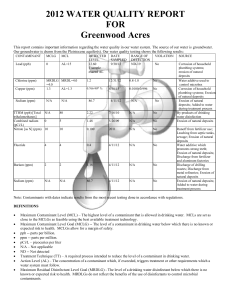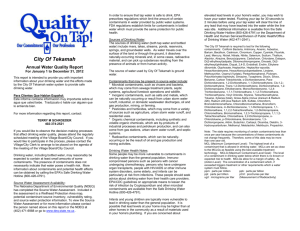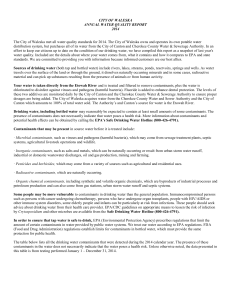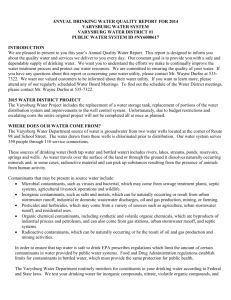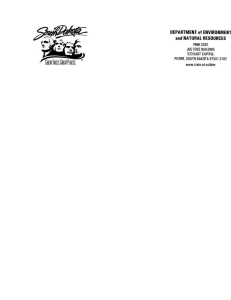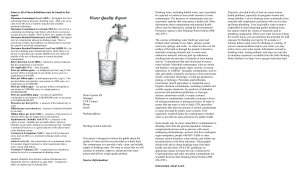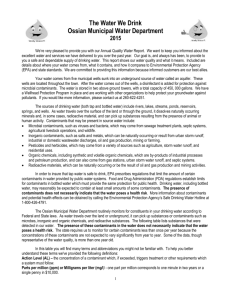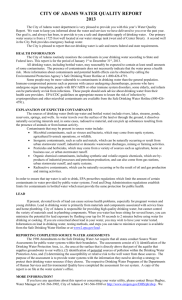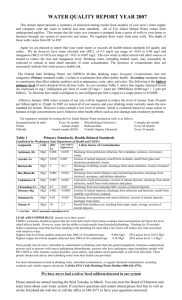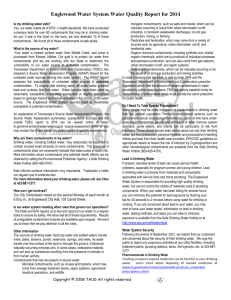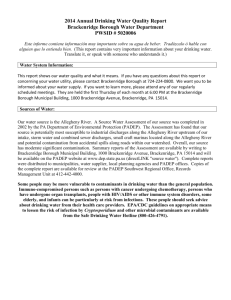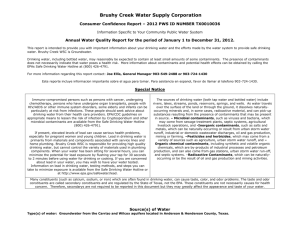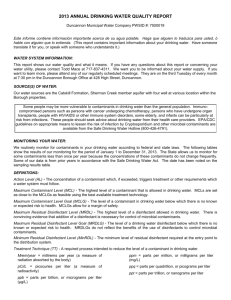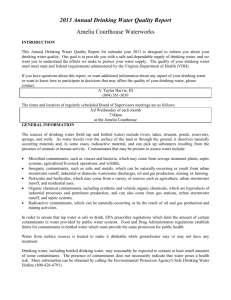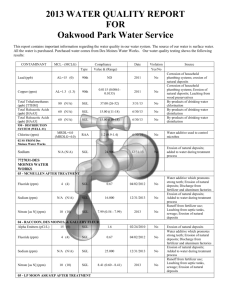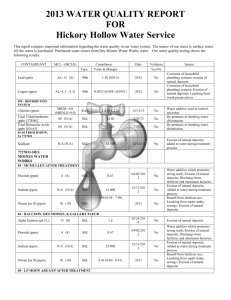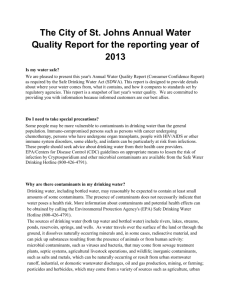Inorganic Contaminants
advertisement
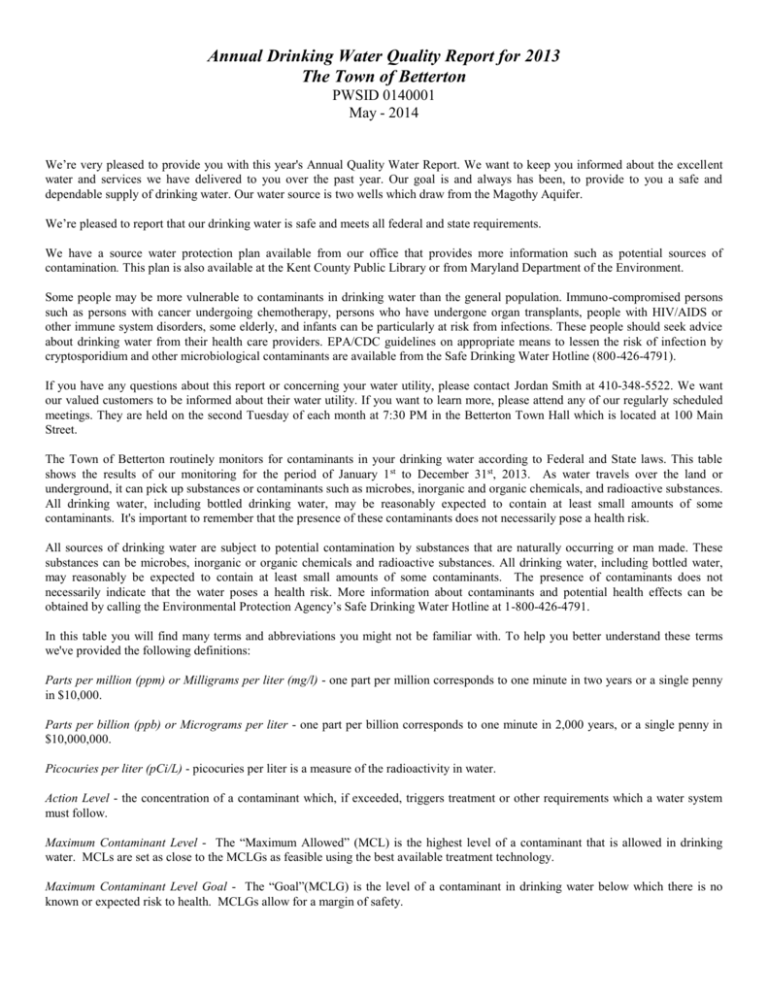
Annual Drinking Water Quality Report for 2013 The Town of Betterton PWSID 0140001 May - 2014 We’re very pleased to provide you with this year's Annual Quality Water Report. We want to keep you informed about the excellent water and services we have delivered to you over the past year. Our goal is and always has been, to provide to you a safe and dependable supply of drinking water. Our water source is two wells which draw from the Magothy Aquifer. We’re pleased to report that our drinking water is safe and meets all federal and state requirements. We have a source water protection plan available from our office that provides more information such as potential sources of contamination. This plan is also available at the Kent County Public Library or from Maryland Department of the Environment. Some people may be more vulnerable to contaminants in drinking water than the general population. Immuno-compromised persons such as persons with cancer undergoing chemotherapy, persons who have undergone organ transplants, people with HIV/AIDS or other immune system disorders, some elderly, and infants can be particularly at risk from infections. These people should seek advice about drinking water from their health care providers. EPA/CDC guidelines on appropriate means to lessen the risk of infection by cryptosporidium and other microbiological contaminants are available from the Safe Drinking Water Hotline (800-426-4791). If you have any questions about this report or concerning your water utility, please contact Jordan Smith at 410-348-5522. We want our valued customers to be informed about their water utility. If you want to learn more, please attend any of our regularly scheduled meetings. They are held on the second Tuesday of each month at 7:30 PM in the Betterton Town Hall which is located at 100 Main Street. The Town of Betterton routinely monitors for contaminants in your drinking water according to Federal and State laws. This table shows the results of our monitoring for the period of January 1 st to December 31st, 2013. As water travels over the land or underground, it can pick up substances or contaminants such as microbes, inorganic and organic chemicals, and radioactive substances. All drinking water, including bottled drinking water, may be reasonably expected to contain at least small amounts of some contaminants. It's important to remember that the presence of these contaminants does not necessarily pose a health risk. All sources of drinking water are subject to potential contamination by substances that are naturally occurring or man made. These substances can be microbes, inorganic or organic chemicals and radioactive substances. All drinking water, including bottled water, may reasonably be expected to contain at least small amounts of some contaminants. The presence of contaminants does not necessarily indicate that the water poses a health risk. More information about contaminants and potential health effects can be obtained by calling the Environmental Protection Agency’s Safe Drinking Water Hotline at 1-800-426-4791. In this table you will find many terms and abbreviations you might not be familiar with. To help you better understand these terms we've provided the following definitions: Parts per million (ppm) or Milligrams per liter (mg/l) - one part per million corresponds to one minute in two years or a single penny in $10,000. Parts per billion (ppb) or Micrograms per liter - one part per billion corresponds to one minute in 2,000 years, or a single penny in $10,000,000. Picocuries per liter (pCi/L) - picocuries per liter is a measure of the radioactivity in water. Action Level - the concentration of a contaminant which, if exceeded, triggers treatment or other requirements which a water system must follow. Maximum Contaminant Level - The “Maximum Allowed” (MCL) is the highest level of a contaminant that is allowed in drinking water. MCLs are set as close to the MCLGs as feasible using the best available treatment technology. Maximum Contaminant Level Goal - The “Goal”(MCLG) is the level of a contaminant in drinking water below which there is no known or expected risk to health. MCLGs allow for a margin of safety. TEST RESULTS Violation Y/N Level Detected Copper (Distribution) (2010) N 0.258 ppm 1.3 AL=1.3 Barium (2009) N 0.064 ppm 2 2 Lead (Distribution) (2010) N 8.0 ppb 0 AL=15 Nitrate (as Nitrogen) N 3.62 ppm 10 10 Arsenic (2009) N < 2.0 ppb n/a 10 N 0 ppb 0 80 By-product of drinking water chlorination N 0 ppb 0 60 By-product of drinking water chlorination N 9 pCi/1 0 50 Decay of natural and man-made deposits N 5 pCi/1 0 15 Erosion of natural deposits Contaminant Unit Measurement MCLG MCL Likely Source of Contamination Inorganic Contaminants Corrosion of household plumbing systems; erosion of natural deposits; leaching from wood preservatives Discharge of drilling wastes; discharge from metal refineries; erosion of natural deposits Corrosion of household plumbing systems, erosion of natural deposits Runoff from fertilizer use; leaching from septic tanks, sewage; erosion of natural deposits Erosion of natural deposits; runoff from orchards; runoff from glass and electronics production wastes Volatile Organic Contaminants TTHM (Distribution) (2013) [Total trihalomethanes HAA5s [Haloacetic acids] (Distribution) (2013) Radioactive Contaminants Beta/photon emitters (2008) Alpha emitters (2008) Synthetic Organic Contaminants including Pesticides and Herbicides Di(2-ethylhexyl) (2009) phthalate N 0.5 ppb 0 6 N 35.0 ppm N/A N/A Discharge from rubber and chemical factories Unregulated Contaminants Sodium (2009) Erosin of natural deposits Note: Test results are for year 2013 unless noted otherwise; testing for all contaminants is not required annually. As you can see by the table, our system had no violations. We’re proud that your drinking water meets or exceeds all Federal and State requirements. We have learned through our monitoring and testing that some contaminants have been detected. The EPA has determined that your water IS SAFE at these levels. If present, elevated levels of lead can cause serious health problems, especially for pregnant women and young children. Lead in drinking water is primarily from materials and components associated with service lines and home plumbing. The Town of Betterton is responsible for providing high quality drinking water, but cannot control the variety of materials used in plumbing components. When your water has been sitting for several hours, you can minimize the potential for lead exposure by flushing your tap for 30 seconds to 2 minutes before using water for drinking or cooking. If you are concerned about lead in your drinking water, you may wish to have your water tested. Information on lead in drinking water, testing methods, and steps you can take to minimize exposure is available from the EPA Safe Drinking Water Hotline at 1-800-426-4791 or at http://www.epa.gov/safewater/lead. MCL’s are set at very stringent levels. To understand the possible health effects described for many regulated contaminants, a person would have to drink 2 liters of water every day at the MCL level for a lifetime to have a one-in-a-million chance of having the described health effect. Our water system is required to collect one routine monthly sample for bacteria testing. These results must be reported to Maryland Department of the Environment (MDE) no later than the 10th day of the following month. Our system received a reporting violation for the months of August and October when MDE did not receive results before the due date of September 10th and November 10th .Violation period was August 1st thru August 31st 2013 and October 1 thru October 31st 2013 . Our system was returned to compliance after results of our testing was received by MDE from our lab. As results were negative for the presence of bacteria, we do not believe that this late reporting created any adverse health effects. Our water system received a Lead and Copper violation from the Maryland Department of the Environment due to not collecting our Lead and Copper samples in 2013. Our water system will return to compliance once we complete these samples in 2014. Thank you for allowing us to continue providing your family with clean, quality water this year. In order to maintain a safe and dependable water supply we sometimes need to make improvements that will benefit all of our customers. These improvements are sometimes reflected as rate structure adjustments. Thank you for understanding.
